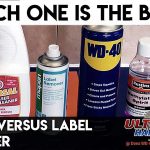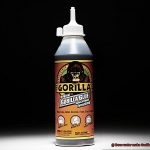Are you a DIY enthusiast or an arts and crafts aficionado? If so, you know the importance of having the right adhesive for your projects. But what happens when you need to bond two different materials together, like epoxy resin and super glue?
Epoxy resin has gained popularity in recent years due to its versatility and durability, while super glue is known for its quick bonding capabilities. However, the question remains: does super glue stick to epoxy resin?
As an adhesive expert, I can tell you that it’s not a straightforward answer. While super glue can adhere to surfaces like epoxy resin, several factors come into play that determine the effectiveness of the bond. The surface area, temperature, and quality of the adhesive used are all critical factors.
This blog post delves deeper into whether super glue sticks to epoxy resin or not. We’ll explore the benefits and challenges of using super glue on epoxy resin surfaces and provide some expert tips on how to ensure a strong bond. So let’s dive in and uncover the secrets of super glue and epoxy resin.
What is Super Glue?
Contents
- 1 What is Super Glue?
- 2 What is Epoxy Resin?
- 3 Types of Epoxy Resin
- 4 Adhesion of Super Glue to Different Types of Epoxy Resin
- 5 Factors Affecting Adhesion of Super Glue to Epoxy Resin
- 6 Application Method for Adhering Super Glue to Epoxy Resin
- 7 Testing the Bond Before Applying to Larger Pieces
- 8 Pros and Cons of Using Super Glue and Epoxy Resin Together
- 9 Conclusion
Super Glue: The Versatile Adhesive That Bonds Almost Anything
Super Glue is an adhesive that has become synonymous with strength and versatility. This fast-acting adhesive, also known as cyanoacrylate glue, bonds almost instantly upon contact with the surface. Its unique composition is a mixture of chemicals that react when exposed to moisture in the air, resulting in a nearly unbreakable bond.
The History of Super Glue
Super Glue was first discovered in 1942 by Dr. Harry Coover while working on developing a clear plastic for gun sights during World War II. Although he initially dismissed the substance due to its stickiness, several years later, he realized its potential and developed it into the modern-day Super Glue we know today.
Applications of Super Glue
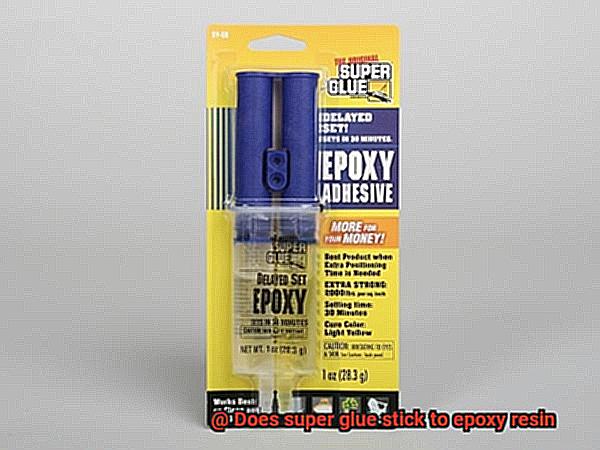
Super Glue is highly versatile and can bond materials such as metal, plastic, rubber, ceramics, and even wood. It is commonly used for repairing small items like jewelry, electronics, and dental crowns. Industries also use Super Glue for bonding parts together quickly and efficiently.
Limitations
As with any adhesive, Super Glue has its limitations. It may not bond well to smooth or non-porous surfaces. Additionally, if applied incorrectly or if adjustments need to be made to your project, removing it can be tricky.
Tips for Using Super Glue
To ensure a strong bond, it’s important to follow these tips when using Super Glue:
- Clean the surfaces to be bonded thoroughly
- Apply a small amount to one surface only
- Hold the surfaces together for at least 10-30 seconds
- Avoid contact with skin or eyes
What is Epoxy Resin?
Look no further than epoxy resin. This thermosetting polymer is made up of two components – a resin and a hardener – that chemically react to form a rigid and durable material. But what makes epoxy resin stand out from other adhesives?
First and foremost, epoxy resin is known for its exceptional adhesive properties. It can bond to a wide range of surfaces including wood, metal, plastic, glass, and ceramics. Its strength and durability make it an ideal choice for bonding different materials together, whether you’re working on a home DIY project or in an industrial setting.
But that’s not all – epoxy resin also has the unique ability to cure at room temperature or with the application of heat. This feature makes it convenient for use in various settings and applications. Plus, its resistance to water, chemicals, and UV rays make it perfect for outdoor use in harsh weather conditions.
In fact, epoxy resin is commonly used in marine environments due to its ability to withstand exposure to saltwater and other harsh elements. Whether you’re repairing a boat or building an outdoor structure, epoxy resin is up to the task.
So what about super glue? While both adhesives are strong and reliable, they have their own unique properties and limitations. Super glue may be great for bonding small items like jewelry or electronics, but when it comes to larger projects or bonding different materials together, epoxy resin is the way to go.
Types of Epoxy Resin
Epoxy resin is a versatile adhesive that is highly popular across industries due to its extraordinary strength and durability. It can bond various materials such as wood, metal, plastic, and concrete, making it an ideal choice for many applications. However, not all epoxy resins are created equal. There are different types of epoxy resins available in the market, each with its unique properties that make it suitable for specific uses. Let’s explore the most common types of epoxy resins and their applications in detail.
Clear Epoxy Resin
This type of epoxy resin is transparent and is often used for casting and coating applications. Clear epoxy resin provides a glossy finish on surfaces, making it ideal for jewelry making, woodworking, and other creative projects. It can also be used to preserve and protect artwork.
Colored Epoxy Resin
Colored epoxy resin comes in a variety of colors and is often used for decorative purposes. It can add color to surfaces or create interesting patterns and designs, making it perfect for artistic projects.
High-Temperature Epoxy Resin
High-temperature epoxy resin can withstand extreme temperatures up to 500°F, making it ideal for industrial applications. It is commonly used in the automotive, aerospace, and electronics industries.
UV Resistant Epoxy Resin
UV resistant epoxy resin is designed to resist fading and yellowing caused by exposure to UV rays. It is often used for outdoor applications such as boat building and repair.
Fast-Curing Epoxy Resin
If you’re working on a project with a tight deadline, fast-curing epoxy resin may be just what you need. This type of epoxy resin dries quickly and can be sanded and painted in as little as one hour.
When using super glue with epoxy resin, it’s important to note that some types of epoxy resin may not bond well with super glue, while others may create a strong and durable bond. It’s always best to test the compatibility of the two adhesives on a small area first before attempting a larger bond. Remember to read the instructions carefully and follow the manufacturer’s recommendations for the best results.
Adhesion of Super Glue to Different Types of Epoxy Resin
The adhesion of super glue to different types of epoxy resin is a complex subject that requires careful consideration of various factors. In this article, we will explore five key factors that can affect the strength and durability of the bond between these two adhesives.
Type of Epoxy Resin:
Not all epoxy resins are created equal. The type of filler used in the resin can make the surface more or less porous, which can affect how well super glue adheres. It’s important to choose the right type of epoxy resin for the job and consider any additives or coatings it may contain.
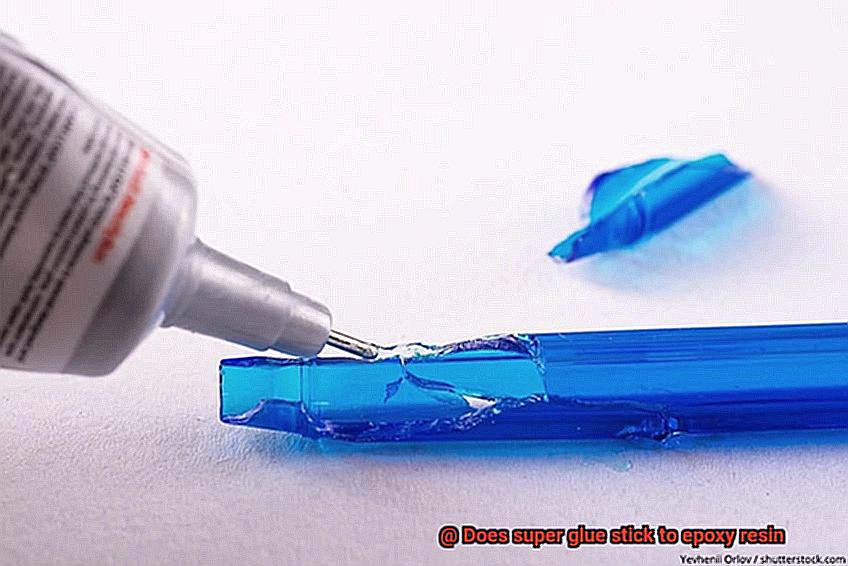
Surface Preparation:
Surface preparation is crucial when bonding epoxy resin with super glue. The surface needs to be clean, dry, and free from any contaminants that may interfere with bonding. Sanding or roughening the surface can also improve adhesion by increasing the surface area for bonding.
Application Method:
The application method of super glue can also affect its adhesion to epoxy resin. Applying too much or too little adhesive can result in weaker bonds or poor coverage. It is essential to apply an appropriate amount of super glue evenly across the surface to ensure maximum contact and bonding strength.
Curing Time and Temperature:
Epoxy resins require a certain amount of time and heat to fully cure and harden. If the resin is not fully cured before applying super glue, it may not be able to form a strong bond with the glue. Additionally, if the resin is cured at too low or too high of a temperature, it may not provide a good surface for the super glue to adhere to.
Additives or Coatings:
Some types of epoxy resins may contain additives or coatings that can make them resistant to adhesion from super glue. In these cases, it may be necessary to prepare the surface of the epoxy resin by sanding or otherwise roughening it up in order to improve adhesion.
Factors Affecting Adhesion of Super Glue to Epoxy Resin
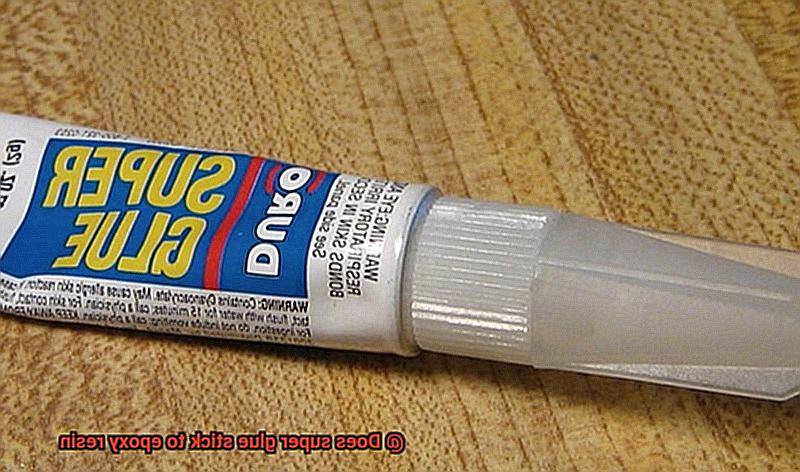
The secret to a durable bond lies in understanding and preparing for the various factors that can affect adhesion.
Firstly, surface preparation is crucial. Both the epoxy resin and the surface it will be bonded to should be free of dirt, dust, and oils. Achieve this by sanding, wiping with alcohol, or using a specialized cleaner.
The ratio of super glue to epoxy resin is also important. Follow the manufacturer’s recommended ratio for optimal strength and adhesion. Too much super glue can weaken the bond, while too little may not provide enough strength.
Temperature and humidity levels during application are critical factors as well. Work in a temperature-controlled environment with moderate humidity levels. High temperatures and humidity can accelerate the curing process, but they can also cause the materials to dry out too quickly or not bond properly.
Choosing the right type of super glue and epoxy resin is also key. Specific types of super glue are designed for bonding with certain materials, so select the appropriate one for use with epoxy resin. Furthermore, some types of epoxy resin may have additives or coatings that can affect adhesion, so always read and follow the manufacturer’s instructions carefully.
Application Method for Adhering Super Glue to Epoxy Resin
I am here to provide you with the ultimate application method for a strong and long-lasting bond between these two materials.
Step 1: Clean the Surface
The first step is to thoroughly clean the surface of both the epoxy resin and super glue using a mild detergent and water. Allow ample time for both surfaces to dry completely before proceeding.
Step 2: Roughen Up the Surface
Next, roughen up the surface of the epoxy resin using sandpaper or a fine-grit abrasive pad. This step is crucial as it creates a better surface for the glue to adhere to. Ensure that all dust and debris created by sanding is removed before proceeding.
Step 3: Apply Super Glue
Apply a small amount of super glue onto the prepared surface of the epoxy resin, but don’t over-apply as this can result in a weaker bond. A good rule of thumb is to use one drop of glue per square inch of surface area.

Step 4: Press Surfaces Together
Press the two surfaces together firmly and hold them in place for at least 30 seconds. It is crucial to ensure that there is uniform pressure applied across the entire surface area to achieve a strong bond. Use clamps or other securing devices if necessary.
Step 5: Allow Glue to Cure
Allow the glue to cure completely before handling or putting any stress on the bond. This can take anywhere from a few minutes to several hours depending on the type of super glue used and environmental conditions. It is recommended to wait at least 24 hours before subjecting the bond to any significant stress.
In conclusion, following these simple steps will ensure a reliable and long-lasting bond between super glue and epoxy resin. Adequate surface preparation, proper application technique, and patience during curing are key factors in achieving successful results.
Testing the Bond Before Applying to Larger Pieces
It’s essential to test the bond before applying it to larger pieces. Don’t risk a weak bond that could lead to disastrous results. Instead, follow these expert tips to ensure a strong and durable bond.
Step 1: Choose the Right Super Glue
Not all super glues are created equal, and choosing the right one can make all the difference. Look for a high-quality super glue that is specifically designed for bonding with plastics and other non-porous surfaces. This will ensure that you achieve the best possible bond between the epoxy resin and super glue.
Step 2: Clean and Prepare the Surfaces
Properly preparing the surfaces is crucial to achieving a strong bond. Make sure to clean the surfaces thoroughly with rubbing alcohol or acetone, removing any dirt, dust, or debris that may interfere with the bond. This step is often overlooked but can significantly impact the bond’s success.
Step 3: Test the Bond
Before applying super glue to larger pieces, test the bond by applying a small amount of super glue to a small area of the epoxy resin. Allow it to dry completely before gently attempting to pull the two pieces apart. If the bond remains intact, it is safe to assume that super glue will stick to epoxy resin.
Step 4: Apply Super Glue and Press Surfaces Together
Once you’ve confirmed that the super glue bonds well with your epoxy resin, apply a small amount of super glue to one surface and press the two surfaces together firmly. Hold them in place for a few seconds until the bond sets. Avoid moving or disturbing the surfaces during this time as this can weaken the bond.
Pros and Cons of Using Super Glue and Epoxy Resin Together
While this combination can create a powerful bond, there are both advantages and disadvantages to consider before you begin.
One of the main advantages of using these two adhesives together is their strength. The combination is perfect for applications where heavy loads or stress will be placed on the bond, such as woodworking, metalworking, or jewelry making. Additionally, the versatility they offer is a plus. Super glue bonds surfaces quickly and easily while epoxy resin fills gaps and creates a more permanent bond. By using them together, you can take advantage of both adhesives’ strengths to achieve optimal results.
However, there are potential drawbacks to consider as well. One issue is that certain materials may not be compatible with either super glue or epoxy resin, let alone when used together. Furthermore, if you need to remove or adjust the bond later on, it may be difficult or even impossible to do so without damaging the materials being bonded.
It’s also worth noting that using both adhesives together can be more expensive than using just one adhesive. This is something to bear in mind if you’re working on a larger project or have a tight budget.
Conclusion
In conclusion, the answer to whether super glue sticks to epoxy resin is not a simple yes or no. The bond’s effectiveness depends on various factors such as surface area, temperature, and adhesive quality.
Epoxy resin is renowned for its exceptional adhesive properties that can bond different materials like wood, metal, plastic, glass, and ceramics. Its strength and durability make it an ideal choice for bonding various materials together.
Combining both adhesives can create a potent bond with numerous advantages like strength and versatility. However, it’s essential to note that certain materials may not be compatible with either super glue or epoxy resin when used together. Additionally, removing or adjusting the bond later on could be challenging or even impossible without damaging the materials being bonded.



